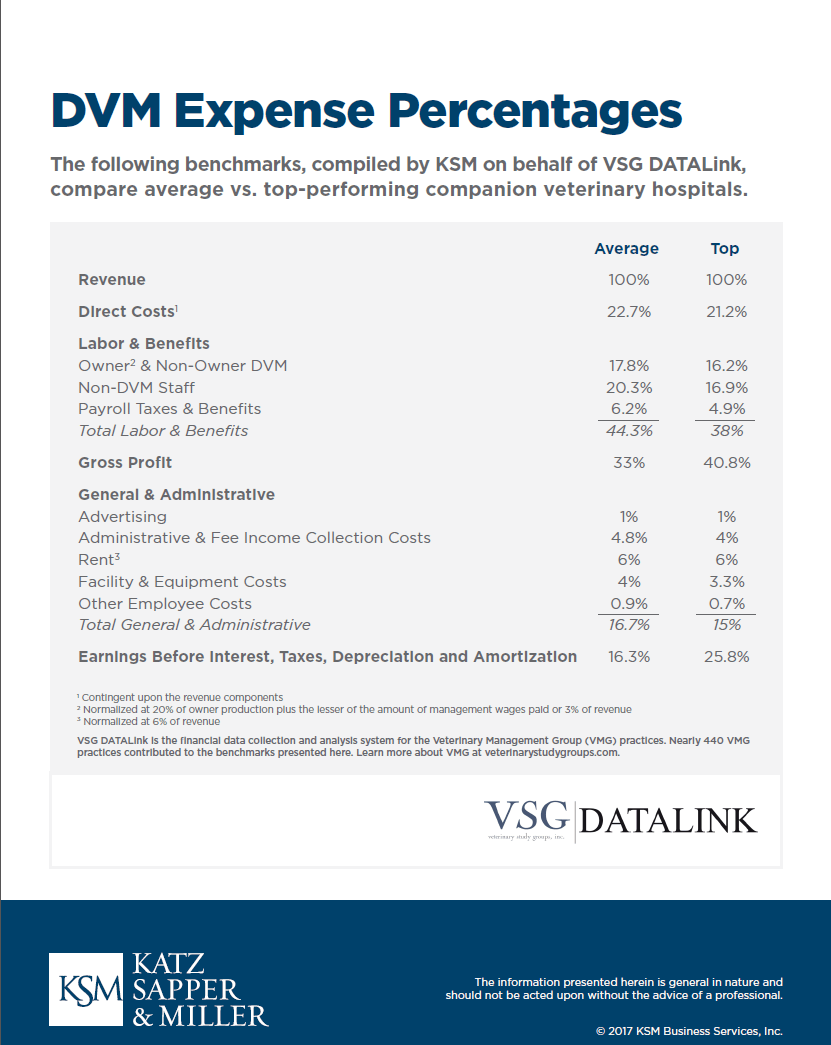
For Practice Managers and Owners
Finances and Operations: Two Keys to Your Success
By Terry O’Neil, Partner-in-Charge, Veterinary Services
Metropolitan Veterinary Associates is a member of Veterinary Study Groups (VSG) whose mission is “To be the leading provider of support to independent practices in their pursuit of extraordinary success through study groups”. Through their partnership with Katz, Sapper & Miller, we’re happy to share information to ensure the health of your hospital. Running a successful veterinary hospital requires more than a heartfelt desire to provide pets with an optimal level of care. Here are a few simple ways you can help improve your hospital’s overall financial and operational performance.
3 BASICS OF BETTER FINANCIAL PERFORMANCE
1. Budgeting. Improved financial performance begins with proper budgeting. Budgeting is not a new financial tool, but it is surprising how few hospitals use it properly. Creating a proper budget allows you to establish a formal financial goal for the year. Having a budget in place will also help you make the required adjustments to keep your year-end goals in reach. We suggest you meet with your business advisor to determine reasonable goals for your hospital’s revenue growth and expenses.
2. Monitoring. After you establish your goals, you have to monitor them. Discussions about monitoring usually generate three simple questions: When? What? How? When should my company look at its key performance indicators (KPIs)? Once every month, you should review your financials and compare your budget to your actual income statement. If you are targeting specific areas of improvement, such as labor or cost of sales, we recommend you review your KPI reports on a weekly or bi-weekly basis, so you can make real-time adjustments to improve your profits.
What specifically should I be monitoring?
The answer to this question depends on your hospital’s specific areas of opportunity. Start with the areas that have the biggest impacts on your bottom line: revenue, labor and cost of sales. Compare your revenue against the same period from the previous year as well as your budgeted revenue goals. Is your labor cost warranted by your revenue? Does it fit within your benchmark and budgeted goals? Lastly, compare your cost of sales against your revenues. Are you hitting your budget goals?
How can I be expected to monitor my financial performance when being a veterinarian already constitutes a demanding full-time job?
Your main focus should be patient care, which is why it is important that you assemble the right team around you. Task your practice manager with creating a KPI that affords you a snapshot of your targeted areas of improvement. The report should provide a simplistic view of your hospital’s performance/metrics. Establish a regular weekly or bi-weekly meeting with your practice manager to review and discuss the report, current performance and goals.
3. Fees. When was the last time you reviewed your hospital’s fee structure? Increasing fees is not always easy, but, at times, it is necessary and appropriate. As your fees stay the same, your costs continue to rise and your profits continue to shrink. We suggest you set aside time once each year to review your hospital’s fee structure and mark-up percentages. When you decide to raise fees, focus first on your non-shopped services.
IMPROVING OPERATIONAL EFFICIENCY
Standards of Care. Creating a consistent standard of care within your hospital impacts your bottom line. Educating your doctors on hospital standards will ensure every patient receives the same high level of care. Patients should receive the same work-up, treatment plan and estimate or invoice regardless of which doctor they see. It is also important to review and compare average client
transactions (ACTs) to ensure they are comparable (specialized medicine excepted). Outliers may present valuable opportunities to discuss best practices.
New Patients. New patients are vital to your hospital’s growth and bottom line. In our “Finances and Operations” Katz, Sapper & Miller experience, patients remain with the hospital for an average of five years. Be sure to review your hospital’s new client numbers and analyze the effectiveness of your new business strategies. You may wish to consider consulting with a veterinary marketing professional to create a marketing plan. Finally, take the time to educate your staff about how important new patients are to your hospital’s future.
Compliance. How much revenue is your hospital missing out on through patient non-compliance? Hospital marketing is usually focused on getting new patients in the door, but you should also take the time to focus on current patient compliance. Take the time to evaluate your hospital’s reminder system and monitor your compliance percentages.
Ask A Question
It’s important that our patients and their families can get to know our doctors and the facility. Ask us a question about anything for a chance to see it answered on our blog.
